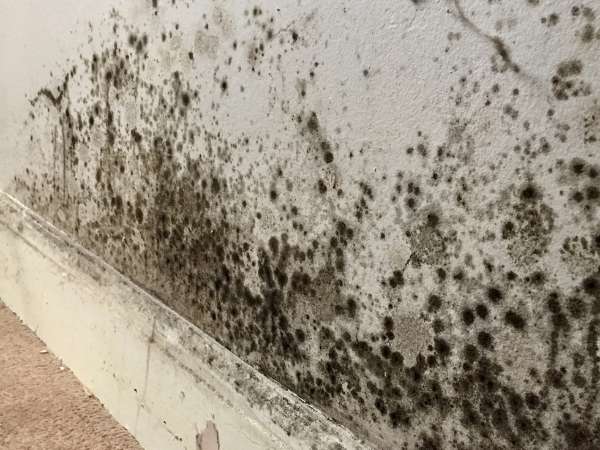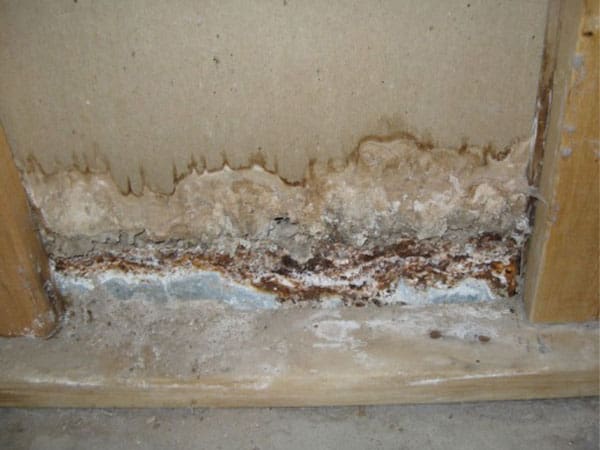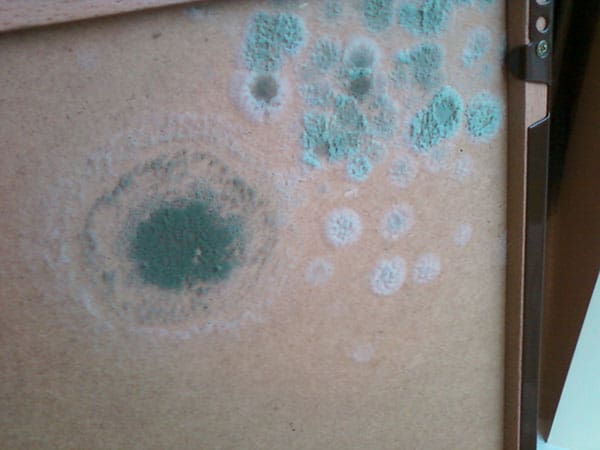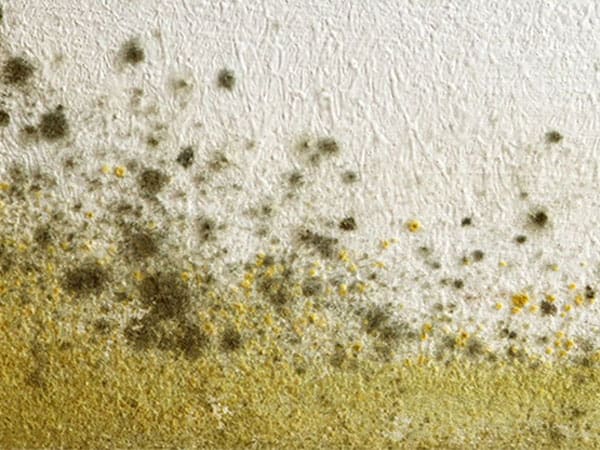In the UK, landlords have a responsibility to ensure that homes are safe and in good repair. This includes addressing issues of damp and mould. The government has proposed new regulations, known as “Awaab’s Law”, which could require social housing landlords to repair mouldy properties more quickly
There are many different types of mould that can be found in UK homes. According to Rentokil, some of the most common types of mould found in homes include Black Mould, Alternaria, Aspergillus, Cladosporium and Penicillium.

Black Mould
Black mould, scientifically known as Stachybotrys chartarum, is a type of fungus that thrives in damp environments. It is commonly found in areas of homes with high moisture levels such as bathrooms, kitchens, laundry rooms, basements, and around windows. It can also grow on building materials that have been damp for a long time, such as after a flood.

Alternaria
Alternaria is a genus of fungi known as Deuteromycetes. It is recognized as a major plant pathogen, affecting over 380 plant species⁶. Alternaria species are also common allergens in humans, often growing indoors and causing hay fever or hypersensitivity reactions that sometimes lead to asthma.

Aspergillus
Aspergillus is a common type of mould that can be found in many homes in the UK. It is typically found in areas with high humidity, poor ventilation, and those that have experienced water damage.
In terms of health effects, exposure to Aspergillus can lead to a variety of health issues. These include respiratory problems, allergies, asthma, and in severe cases, it can be fatal. The mould produces allergens, irritants, and sometimes, toxic substances. Inhaling or touching mould spores may cause an allergic reaction, such as sneezing, a runny nose, red eyes, and skin rash. Mould can also trigger asthma attacks.
Aspergillus is a genus of molds that comprises several hundred species. It was first discovered in 1729 by an Italian priest and biologist named Pier Antonio Micheli2. Aspergillus spores spread in the air and are thought to be more concentrated indoors than outdoors. The mold can be found in various places, including soil, compost, rotting leaves, plants, trees, crops, dust, damp buildings,and air conditioning systems.
Aspergillosis is a condition caused by inhaling tiny bits of aspergillus mold. Most people who breathe in the mold do not get ill, as the body’s immune system destroys them4. However, aspergillosis can develop in people with an existing lung condition or a weakened immune system34. Symptoms of aspergillosis include shortness of breath, a cough (which may bring up blood or mucus), wheezing, a high temperature of 38C or above, weight loss, and fatigue.
There are diferent types of aspergillosis infection, most of which affect the lungs and cause breathing difficulties. These include:
- Allergic bronchopulmonary aspergillosis (ABPA) – an allergic reaction to aspergillus mold, usually in people with asthma or cystic fibrosis.
- Chronic pulmonary aspergillosis (CPA) – a long-term (chronic) infection in the lungs.
- Acute invasive pulmonary aspergillus (IPA) – a life-threatening infection in people with a weakened immune system where the fungal infection has spread into the lung tissues.
- Aspergilloma – a ball of mold in the lungs which usually occurs in areas of the lung damaged by previous infections, such as tuberculosis.
Treatment for aspergillosis depends on the type and usually helps control the symptoms. If it’s not treated or well controlled, there’s a risk it could damage your lungs. It’s almost impossible to completely avoid aspergillus mold, but there are things you can do to reduce your risk of aspergillosis if you have a lung condition or weakened immune system.

Cladosporium is a common mold that can grow both indoors and outdoors. It is a genus that consists of various indoor and outdoor mold species. Cladosporium may appear as brown, green, or black spots. It is more common in areas with humidity, moisture, and water damage.
Indoors, Cladosporium often grows on objects such as carpets, curtains, upholstery, and wallpaper. It can also appear on window sills and plywood. It is more likely to grow in wet or damp areas, bathrooms, basements, areas near heating and cooling appliances, and attics.
Exposure to Cladosporium affects people in different ways. Some people may develop an allergic reaction, while others may not1. Symptoms of an allergic reaction may include dry skin, sneezing, stuffy or runny nose, coughing, postnasal drip, itchy throat, eyes, and nose, and watery eyes. Severe reactions include serious asthma attacks and allergic fungal sinusitis1.
Most species of Cladosporium are not dangerous to humans, but the spores can still be dangerous for humans. Long exposure can cause various health conditions, such as eye infections, ear infections, skin problems, sinus infection, and allergic reactions. People with allergies can get their symptoms triggered by Cladosporium mold spores. They may experience asthma-like symptoms, sneezing, coughing, red eyes, and other common allergy signs.
It’s important to note that it can be difficult to identify Cladosporium in your home without professional help1. If you suspect you have a mold problem, consider hiring a professional mold tester or company to inspect your home
Mould, a common household nuisance, comes in various forms, each with its own unique characteristics and potential health risks. While some may consider mould as a mere inconvenience, it is important to acknowledge that it has the potential to cause severe health problems. To better understand the implications of mould exposure, it is crucial to delve into its reproductive mechanism. In its quest to reproduce and spread, mould generates minuscule particles known as spores. These spores are effortlessly carried through the air and can be inhaled by unsuspecting individuals, particularly those who are sensitive or allergic to mould. Once inhaled, these spores can instigate a cascade of health issues, ranging from mild inconveniences to more serious complications. One of the most commonly observed health effects of mould exposure is respiratory distress. People who inhale mould spores may experience symptoms such as a persistently runny or congested nose, both of which can cause immense discomfort. Additionally, irritation of the eyes and skin is not uncommon, leading to itchiness, redness, and general discomfort. In more severe cases, individuals may even experience wheezing, making it difficult to breathe properly. However, it is imperative to highlight that individuals with pre-existing respiratory conditions, such as asthma, are particularly vulnerable to the adverse effects of mould. For those with asthma, the inhalation of mould spores can trigger asthma attacks, which can be life-threatening if not promptly managed. Thus, it is crucial for individuals with asthma to remain vigilant and take necessary precautions to minimize their exposure to mould. While most cases of mould exposure result in mild to moderate symptoms, there are rare instances when individuals develop severe mould infections. These infections, typically found within the lungs, can be highly detrimental to one’s health and require immediate medical attention. It is important to note, however, that such cases are relatively uncommon and should not incite unnecessary alarm. To safeguard oneself against the potential hazards of mould, it is prudent to adopt preventive measures within the living environment. Regularly cleaning and maintaining areas prone to mould growth, such as bathrooms and kitchens, can significantly reduce the likelihood of its presence. Adequate ventilation, both within and outside the home, is also crucial in preventing the accumulation of moisture, which fosters mould growth. Furthermore, it is advisable for individuals to seek professional assistance if they suspect a significant mould infestation within their homes. Trained experts can assess the severity of the situation and employ appropriate remediation techniques to eliminate the mould effectively. By taking these proactive measures, individuals can ensure a healthier living environment and mitigate the potential health risks associated with mould exposure. In conclusion, mould, though seemingly innocuous, should not be underestimated. Its ability to produce spores and disseminate them through the air poses a potential threat to human health. From mild irritations to severe respiratory distress, mould exposure can take a toll on individuals, especially those with pre-existing conditions such as asthma. By adopting preventative measures and seeking professional assistance when needed, individuals can minimize the risks associated with mould and create a safer living environment for themselves and their loved ones.
